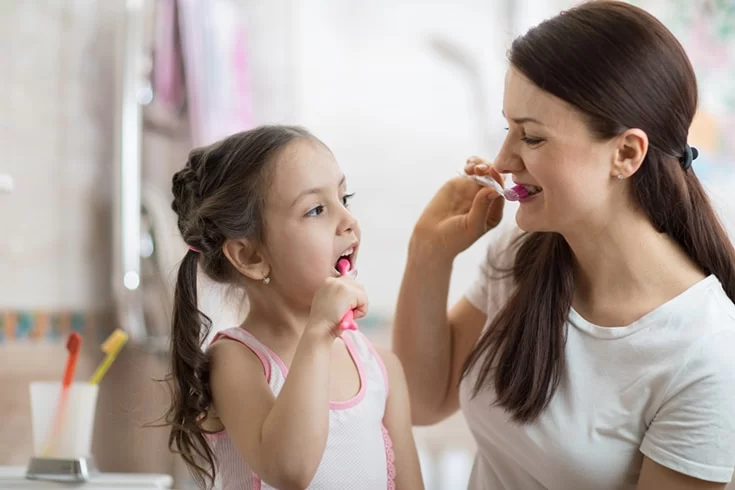
How to Prevent Oral Diseases in Toddlers: A Parent's Guide to Healthy Teeth
- 1. Importance of Oral Health for Toddlers
- 2. Best Brushing Habits for Toddlers
- 3. Choosing the Right Toothbrush and Toothpaste for Toddlers
- 4. Healthy Diet for Toddlers' Teeth
- 5. When to Start Dental Visits for Toddlers
- 6. Real-Life Example: Preventing Oral Diseases in Toddlers
1. Importance of Oral Health for Toddlers
Good oral health is crucial for toddlers, as it lays the foundation for their future dental well-being. Poor oral hygiene can lead to various dental diseases like cavities, gingivitis, and even more severe conditions like gum disease. Establishing healthy habits early on can prevent these issues and promote long-term oral health. Moreover, healthy teeth and gums are essential for speaking, eating, and smiling, which are vital developmental milestones for toddlers.
Parents play a critical role in guiding their children to develop good oral hygiene habits, starting from an early age. By doing so, they can ensure that their toddlers' teeth and gums stay healthy as they grow, which helps to avoid dental problems later in life.
2. Best Brushing Habits for Toddlers
Brushing toddlers' teeth can seem challenging, but it’s an essential habit to establish early. Here are some best practices to keep in mind:
- Brush Twice a Day: Just like adults, toddlers need to brush their teeth twice a day. Morning and evening brushing is essential to remove food particles and plaque.
- Use a Soft-Bristled Toothbrush: Choose a soft-bristled toothbrush specifically designed for toddlers. A soft brush ensures that their delicate gums aren’t harmed while brushing.
- Supervise Brushing: Parents should supervise toddlers while brushing. Even though toddlers can begin to brush independently, they still need assistance to ensure they are brushing correctly.
- Fluoride-Free Toothpaste: For toddlers under 2 years, use fluoride-free toothpaste to prevent swallowing too much fluoride. Around age 2, you can switch to a fluoride toothpaste with a small, pea-sized amount.
3. Choosing the Right Toothbrush and Toothpaste for Toddlers
Choosing the right toothbrush and toothpaste is essential to ensure that your toddler’s teeth are properly cleaned. Here’s how to choose the best options:
- Toothbrush: A toddler-sized toothbrush with soft bristles is perfect for little mouths. Look for one with a small head to reach all parts of the mouth and a handle that’s easy for little hands to hold.
- Toothpaste: Start with fluoride-free toothpaste for babies and toddlers under two years. Once your child is older than two, you can introduce fluoride toothpaste, but remember to only use a small amount to prevent swallowing too much fluoride.
- Toothbrush Replacement: Replace your toddler's toothbrush every 3-4 months or sooner if the bristles start to fray.
4. Healthy Diet for Toddlers' Teeth
Diet plays a significant role in maintaining healthy teeth in toddlers. Here are some essential dietary tips for strong teeth:
- Limit Sugary Foods: Avoid giving your toddler sugary snacks and drinks that can contribute to cavities. Opt for healthier options like fruits, vegetables, and whole grains.
- Encourage Calcium-Rich Foods: Foods rich in calcium, such as dairy products, leafy greens, and fortified cereals, promote strong teeth and bones.
- Offer Water: Water is the best drink for toddlers, as it helps wash away food particles and bacteria that can lead to cavities.
5. When to Start Dental Visits for Toddlers
It’s recommended to schedule your toddler’s first dental visit by their first birthday or within six months after their first tooth appears. Early dental visits help to catch any issues early, provide preventive care, and build good relationships with the dentist. This also sets the foundation for a lifetime of good oral health habits.
During the visit, the dentist will examine your child’s teeth and gums, offer advice on proper brushing techniques, and guide you on nutrition and fluoride use. These regular check-ups will ensure your toddler’s oral health remains in top shape.
6. Real-Life Example: Preventing Oral Diseases in Toddlers
Sarah, a mother of two toddlers, began practicing good oral hygiene with her children from a young age. She ensured that her toddlers brushed twice a day with a soft-bristled toothbrush and fluoride-free toothpaste. Additionally, she limited sugary snacks and promoted water drinking. By following these habits and keeping up with regular dental check-ups, Sarah’s toddlers have healthy teeth and gums, with no signs of cavities or gingivitis. This shows how proactive dental care can lead to a lifetime of healthy smiles.







 Ideal Dental Gallatin4.0 (362 review)
Ideal Dental Gallatin4.0 (362 review) Pro Dentists of Buford4.0 (575 review)
Pro Dentists of Buford4.0 (575 review) Reynolds Family Dentistry of Richmond4.0 (19 review)
Reynolds Family Dentistry of Richmond4.0 (19 review) Dr. Samantha L. Greer, DDS, PA3.0 (25 review)
Dr. Samantha L. Greer, DDS, PA3.0 (25 review) Midland Park Family Dentistry5.0 (447 review)
Midland Park Family Dentistry5.0 (447 review) Dentistry At Suburban Square: Michael I. Wollock, DMD4.0 (1228 review)
Dentistry At Suburban Square: Michael I. Wollock, DMD4.0 (1228 review) The Importance of Oral Health Education During Pregnancy for a Healthy Pregnancy
The Importance of Oral Health Education During Pregnancy for a Healthy Pregnancy Best Tips for Brushing Your Teeth Properly for Healthy Gums: Essential Techniques for Oral Health
Best Tips for Brushing Your Teeth Properly for Healthy Gums: Essential Techniques for Oral Health Why Skipping Dental Checkups Can Lead to Bigger Oral Health Problems
Why Skipping Dental Checkups Can Lead to Bigger Oral Health Problems Advantages of Porcelain Dental Restorations
Advantages of Porcelain Dental Restorations How Can Diabetes Cause Tooth and Gum Problems? Preventing and Managing Oral Health Issues
How Can Diabetes Cause Tooth and Gum Problems? Preventing and Managing Oral Health Issues Healthy Habits for Promoting Good Oral Health and Hygiene: Tips for a Healthy Smile
Healthy Habits for Promoting Good Oral Health and Hygiene: Tips for a Healthy Smile